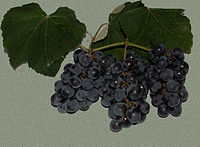
Photo from wikipedia
'Concord', the most well-known juice grape with a parentage of the North American grape species Vitis labrusca L., possesses a special 'foxy' aroma predominantly resulted from the accumulation of methyl… Click to show full abstract
'Concord', the most well-known juice grape with a parentage of the North American grape species Vitis labrusca L., possesses a special 'foxy' aroma predominantly resulted from the accumulation of methyl anthranilate (MA) in berries. This aroma, however, is often perceived as an undesirable attribute by wine consumers and rarely noticeable in the common table and wine grape species V. vinifera. Here we discovered homology-induced promoter indels as a major genetic mechanism for species-specific regulation of a key 'foxy' aroma gene, anthraniloyl-CoA:methanol acyltransferase (AMAT), that is responsible for MA biosynthesis. We found the absence of a 426-bp and/or a 42-bp sequence in AMAT promoters highly associated with high levels of AMAT expression and MA accumulation in 'Concord' and other V. labrusca-derived grapes. These promoter variants, all with direct and inverted repeats, were further confirmed in more than 1,300 Vitis germplasm. Moreover, functional impact of these indels was validated in transgenic Arabidopsis. Superimposed on the promoter regulation, large structural changes including exonic insertion of a retrotransposon were present at the AMAT locus in some V. vinifera grapes. Elucidation of the AMAT genetic regulation advances our understanding of the 'foxy' aroma trait and makes it genetically trackable and amenable in grapevine breeding.
Journal Title: Horticulture research
Year Published: 2020
Link to full text (if available)
Share on Social Media: Sign Up to like & get
recommendations!